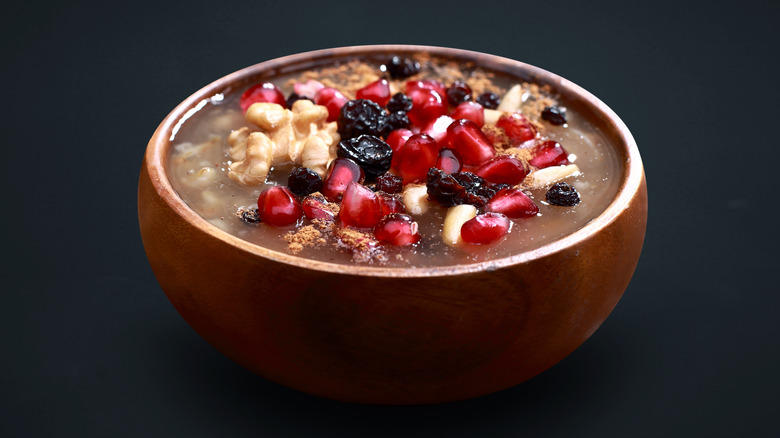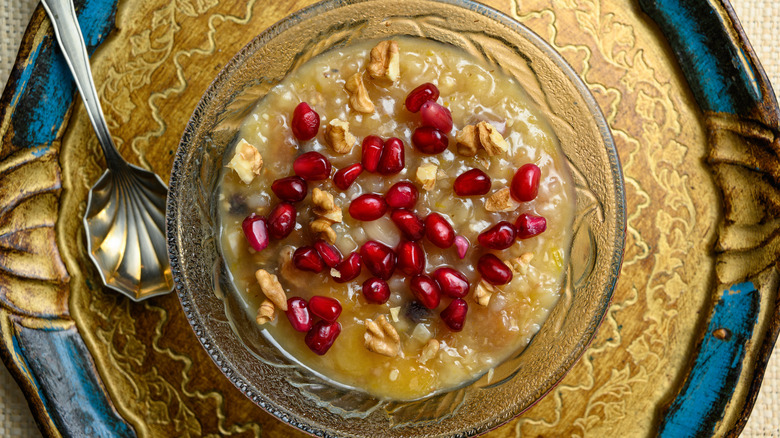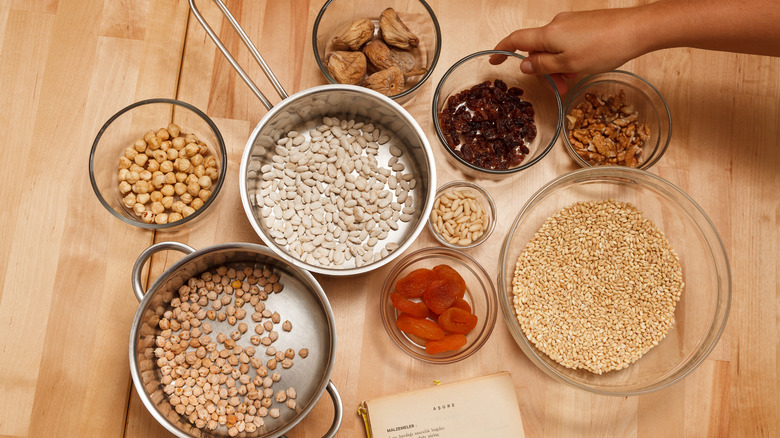The Savory Ingredients Featured In One Of The World's Oldest Desserts
How old is the idea of dessert? It's a slightly tricky question to answer. A few decades can make treats seem like old-timey desserts, sure, but the history of this concept deals more in centuries or even millennia. It can sometimes prove difficult to pinpoint the origins of specific sweets (for example, the cream puff has quite a mysterious history), but luckily for culinary historians, the term "dessert," at least, has an obvious source.
As explained by JSTOR Daily, the English word "dessert" comes from "desservir." This Renaissance-era French term, per Saveur, referred specifically to candied fruits and nuts served at the end of savory meals. Those items gradually evolved into ever more complex forms, leading to the varied dessert world we all know and love today. That's a fairly pedantic, Westernized way to look at the origins of dessert, though.
People have been enjoying sugary delights for as long as folks have been eating. Was a piece of fresh fruit consumed after a meaty meal in prehistoric times technically dessert, though? As we said, it can be slightly tricky determining how old the idea of dessert is. Nevertheless, in our quest for answers, it would be a shame to get too specific and discount some of the oldest desserts in the world, including a somewhat savory dish that has endured in popularity since biblical times.
Ashure is a time-honored tradition
It's a bit strange that a savory dish is considered a dessert, but closed-mindedness is the enemy of appreciation, and there's a whole lot to appreciate about ashure. As explained by BBC Travel, ashure is a millennia-old treat traditionally consisting of nuts, legumes, grains, and fruits. That fruit makes this custardy porridge sweet enough to qualify as a dessert, and nowadays, sugar and spices are often added for an extra kick. However, its grains, legumes, and nuts give ashure a notably savory taste. Such ingredients are also filling, nutritious, and help to balance flavors, thus underscoring ashure's cultural symbolism.
Adherents of some Abrahamic religions believe that ashure was first made by the mythical figure of Noah, who used whatever ingredients were left on his Ark when the Great Flood ended to whip up the world's oldest dessert. As such, ashure is also known as "Noah's Pudding," and it's quite popular in modern Turkey (Noah's final destination), although not exclusively.
That's not the end of ashure's religious meanings, either. "Ashure" translates in Arabic to "ten", significant because Day 10 of the Islamic calendar's first month marks the martyrdom of the Prophet Mohammed's grandson (via New Lines Magazine). Now, the day is seen as a time to celebrate community and prosperity. Plus, there are even variants of ashure found across the Middle East and Eastern Europe. It's probably an exaggeration to claim ashure is truly the world's oldest dessert, but it's certainly one of its most beloved.
Ashure remains sweetly relevant
Ashure might have ancient roots, but it's still enjoyed by many in the modern world. The dessert, per BBC Travel, is regularly made and shared by certain religious and cultural groups around the time of its namesake holiday. At other times of the year, it may be a bit harder to track down, but some dessert shops in various parts of the world sell it continuously.
Yet, the ashure recipe varies. Suna Çağaptay, writing for New Lines Magazine, describes how they updated their family's traditional recipe as an adult, adding a dozen new ingredients. Anything from apricots, black-eyed peas, coconut flakes, fennel, and honey to orange zest, pomegranate seeds, star anise, rosewater, and turmeric can now be found in ashure and its variants. As globalization increases, the dish continues to spread even farther from its origin points, too.
The New York Times notes how London has at least one restaurant serving ashure in the present day. There, however, a chef by the name of Sarit Packer decided to modernize the recipe, turning it into more of a crunchy, sugary cereal and making ashure less of an acquired taste for those who didn't grow up with it. In another corner of the world, circa 2016, thousands of people congregated to watch the world's largest ashure — 10 meters in diameter — get made in Thailand (via the Bangkok Post). This record-setter included banana, cassava, pumpkin, rice, and taro. Talk about a historic dessert worth savoring!


